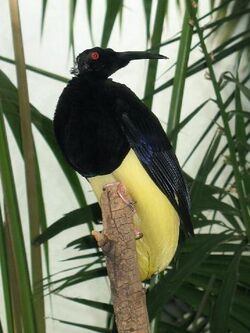Biology:Twelve-wired bird-of-paradise
| Twelve-wired bird-of-paradise | |
|---|---|

| |
| Male | |
| Scientific classification Error creating thumbnail: Unable to save thumbnail to destination
| |
| Domain: | Eukaryota |
| Kingdom: | Animalia |
| Phylum: | Chordata |
| Class: | Aves |
| Order: | Passeriformes |
| Family: | Paradisaeidae |
| Genus: | Seleucidis Lesson, RP, 1834 |
| Species: | S. melanoleucus
|
| Binomial name | |
| Seleucidis melanoleucus (Daudin, 1800)
| |
| Subspecies[2] | |
|
S. m. auripennis | |
| Synonyms | |
| |
The twelve-wired bird-of-paradise (Seleucidis melanoleucus) is a medium-sized, approximately 33 cm (13 in) long, velvet black and yellow bird-of-paradise. The male has a red iris, long black bill and rich yellow plumes along his flanks. From the rear of these plumes emerge twelve blackish, wire-like filaments, which bend back near their bases to sweep forward over the bird's hindquarters. The female is a brown bird with black-barred buffy underparts. Their feet are strong, large-clawed and pink in color.
The display dance of the twelve-wired bird of paradise is called a wire-wipe display and it is performed by males to attract females by showing their flank plumes and bare pigmented thighs. Males use their 12 flank plume "wires" to make contact with the female by brushing across the female's face and foreparts.[5]
The sole representative of the monotypic genus Seleucidis, the twelve-wired bird-of-paradise is a bird of lowland forests. The male displays on an exposed vertical perch with his breast-shield flared. Their diet consists mainly of fruits and arthropods in addition to frogs, insects, and nectar.[6]
They are found in flat lowlands and swamp forests,[6] particularly throughout New Guinea and Salawati Island, Indonesia. The twelve-wired bird-of-paradise is evaluated as Least Concern on the IUCN Red List of Threatened Species,[1] and is listed on Appendix II of CITES. It has not been easy to breed them in captivity. The first successful captive breeding program was at Singapore's Jurong Bird Park, in 2001.[7]
Gallery
References
- ↑ 1.0 1.1 BirdLife International (2018). "Seleucidis melanoleucus". IUCN Red List of Threatened Species 2018: e.T22706233A130413197. doi:10.2305/IUCN.UK.2018-2.RLTS.T22706233A130413197.en. https://www.iucnredlist.org/species/22706233/130413197. Retrieved 13 November 2021.
- ↑ Priese, Max (1909). "Ueber die Einwirkung periodisch erzeugter Dyspnoe auf das Blut". Zeitschrift für experimentelle Pathologie und Therapie 5 (3): 562–578. doi:10.1007/bf02622281. ISSN 0372-8552. http://dx.doi.org/10.1007/bf02622281.
- ↑ Steven Gregory; Edward Dickinson (2012). "Notes on the dating of Lesson's Histoire Naturelle des Oiseaux de Paradis et des Épimaques" [n.d. 1834-1835"]. Zoological Bibliography (2012 2(2&3)): 123. https://www.researchgate.net/publication/267922814. Retrieved 2017-10-21.
- ↑ René Primevère Lesson (1835). Histoire naturelle des oiseaux de paradis et des épimaques. A. Bertrand. p. 29. https://archive.org/details/bub_gb_NyAOAAAAQAAJ. Retrieved 2017-10-21. "Epimachus albus."
- ↑ Clifford B. Frith, Dawn W. Frith. (1997) Courtship and Mating of the King of Saxony Bird of Paradise Pteridophora alberti in New Guinea with Comment on their Taxonomic Significance. Emu - Austral Ornithology 97:3, pages 185-193.
- ↑ 6.0 6.1 Michael, Hugill (24 March 2011). "Twelve-wired Bird of Paradise". http://australianmuseum.net.au/Twelve-wired-Bird-of-Paradise.
- ↑ "Wildlife Reserves Singapore". http://www.wrs.com.sg/parks-info-about-parks.html.
External links
- BirdLife Species Factsheet
- Video showing Bird-of-Paradise courting a female Tim Laman. Jayapura Western New Guinea. June 2010.
Wikidata ☰ Q795568 entry
 |




